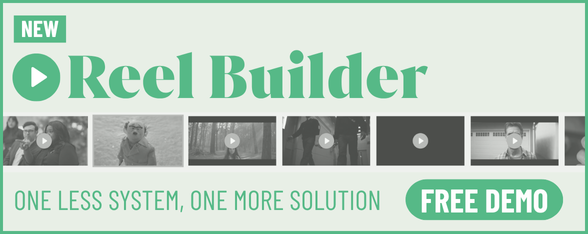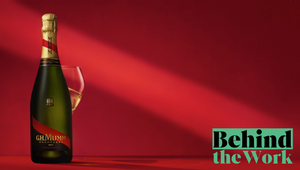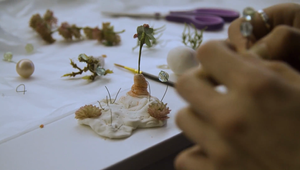
Lighting and Form Guide Nik Mirus on Every Project

Nik Mirus - a creative multi-hyphenate who wears director, DOP, and photographer hats interchangeably - says that he’s not a “control freak.” However, control is clearly something he values as he really likes the technical side of image production: creating the right lighting set up, framing, and basically all the preliminary aspects that make for a great final image. On many projects, he frequently takes on the dual or even the triple role, and has a hand in every part of an image creation, moving or still. Always full of original ideas, it's likewise vital for Nik to “be seen as a collaborative partner,” he adds, since agencies and clients ultimately have a granular understanding of the product and brand.
Nik’s visual style is clearly driven by a particular attention to form. Objects appear alive, three dimensional, and elevated into the realm of the luxe and the fantastical. In his commercial work, this translates to alluring product odes, like the gold-dipped Crown Royal spot. Though the brief called for a fully CGI approach, Nik - committed as he is to the ‘in-camera’ process - suggested the agency take a different approach. The end result is a visually luscious and tactile exploration of the apple-flavoured whisky made using a tank of golden liquid and featuring a cast of live snakes.
As an artist, Nik is interested in investigating the essence of “mundane” objects stripped of their intended use. Once something is obsolete, he observes, is when there's an opportunity to “create something new and unexpected.” Nik also spends a lot of time working and experimenting with technology in his art and he’s excited to soon visit the Toronto Metropolitan University’s ‘fabrication lab’ to create ever more intricate images using robotic arms.
Today, LBB’s Zhenya Tsenzharyk asked Nik about the appeal of the still versus moving image, staging the perfect shot, and the importance of working collaboratively with clients.
BTS of the Crown Royal spot
LBB> You often act as the DOP and the director on projects - do you enjoy that kind of creative control? Which projects have you pulled double duty on and how did you find working on them?
Nik> From time to time, I take on both the role of director and director of photography. On a very basic level, I love creating images. Framing up shots, building lighting setups and working out technical challenges…I love this aspect of photography. I don’t consider myself a control freak, but this is one role that I feel reluctant to give up. It’s an aspect of a production that I feel most in control of. This being said, it can be a lot to juggle both roles on set as they are both very demanding.
On projects such as Digital Architecture, a personal exploration of the sculptural work of David Umemoto, I wore both hats. Thankfully, I was supported by really strong technical teams which allowed me to do both. However, there are times when I need to step aside and secede some of that control.
LBB> Why are you finding that directing is the right path for you today?
Nik> I’ve always enjoyed new challenges and learning new skills. The act of ‘directing’ feels like both a logical step and to a certain degree, a necessity. Over the past few years, I have found that clients have been requesting more motion assets. Whether it be simple looping gif images, or cinemagraphs of longer live action sequences, there is more demand for moving images. I have never consciously set out to be a director, it’s just kind of happening in natural and organic fashion. It has been a challenging process but one that I am enjoying.

BTS on set of the photographic explorations in the stations of the Montreal subway
LBB> You started your creative career as a photographer so we have to ask, why the still image? What do you find appealing about the medium? Do you remember the first photograph that made an impact on you?
Nik> I first became interested in photography as many young photographers do, by documenting and capturing the things and events around them. I enjoyed going out taking pictures of streetscapes, landscapes around my hometown and taking pictures of friends. I can’t say for sure if there was a particular photograph that made an impact on me but I remember being interested in the early work of Philip Lorca DiCorcia. They were portraits of his friends and family that were captured in everyday environments, often doing mundane tasks. The way they were framed, their colour and the way they were lit with a mix of artificial and ambient light really peaked my interest. After reading more about his process I learned that they were staged images. It was the basic idea of building a moment rather than capturing a subject in front of the camera that struck me. The concept has stayed with me ever since.

Nik's photographic explorations in the stations of the Montreal subway
LBB> Where and to what kind of subjects/objects is your eye most often drawn to in still and moving images? Is there anyone’s work or style that you particularly admire?
Nik> The subjects of my commercial work often focus on the latest product, service or trend. Whether it be photographing a new running sneaker or capturing a recipe for a cocktail, the subjects tend to be new and shiny. My role as a photographer and director is to make them look as desirable and as good as possible.
Paradoxically, my personal work is built around objects that are mundane or obsolete. My eye is drawn to simple things. By stripping away its original use, an object’s form, line, texture and materiality become building blocks to create something new and unexpected. Working with pieces of debris, half-used paint cans or archaic medical apparatuses, I try to breathe new life into these discarded materials and give them the same treatments as I would luxury goods.
LBB> You’re repped by L'Éloi - why is this a good home for you and your style of working?
Nik> I’ve been repped by L’Eloi for close to ten years. The production company has given me a tremendous amount of support and encouragement to develop as a commercial photographer and director while giving me the space and resources to pursue personal creative endeavours. I’ve been given opportunities that I might not have had on my own. Both L’Eloi and myself have evolved and grown together. We’ve learned to navigate new mediums, bigger jobs and new commercial markets. We have developed a mutual trust and this has been at the heart of the partnership since day one.
In the 'Digital Architecture' project, Nik pays homage to artist David Umemoto
LBB> Tell us a little bit about the Lab project you’re working on in Toronto and how it’s helping you to develop as an artist.
Nik> For the past few years I have been exploring the use of long exposure techniques with coloured forms in my personal photography work. With the use of simple mechanical devices such as robotic sliders and motors I ‘drag’ coloured, two-dimensional shapes across the picture plane. An illusion of depth and three-dimensionality is created when the coloured shapes overlap with each other. The end result is abstract images that blur the lines between painting, graphic design and photography. The mechanical tools that I have been using in Montreal have been allowing me to do very simple movements. I’ve been able to make objects move laterally along an axis left/right or up/down with relative ease. I’m excited to go to Toronto to work in the Toronto Metropolitan University’s ‘fabrication lab’. With the use of some of their robotic arms I hope to have greater control and variety in the movements, creating more intricate images. I’m looking forward to the process!
LBB> Your spot for Crown Royal is highly evocative - it’s sumptuous, sensual, seductive. What was the brief on the project and how did you make it your own?
Nik> The brief was to create a series of surreal, lush and surprising images that would fit the Crown Royal Golden Apple brand. It was an interesting challenge in the sense that it was first conceived as a project to be done fully in CGI. As a photographer and DP I love the tactile process of working with my hands and doing as much as I can ‘in camera’. To make the project my own, I suggested to the agency that we do as many of the shots practically as possible. This required building a tank filled with fake liquid gold, a surreal forest, shooting live snakes and real liquids. We then added CGI elements to the practically shot scenes. I think it’s this mix of techniques that make it so interesting. I’m proud that we were able to mix the two so seamlessly.

Still from the Crown Royal spot
LBB> How do you strike the balance between being open/collaborative with the agency and brand client while also protecting the idea?
Nik> I want to be seen as a collaborative partner. Agencies put a lot of work into putting together creative approaches and have an understanding of their clients’ market. I will always come to a project with my opinions on how we should approach a subject or concept. However, I realise that my ideas may not always be the right ones. I often do not have the full picture of a brand’s needs. I may push for certain ideas but try to be open minded. It’s a collaborative industry. I understand that there are other ways to see things or convey a message.
LBB> Finally, what’s next on the horizon for you? We heard that you’re working with robots and architecture - how is this figuring into your artistic practice?
Nik> Aside from experimenting with the robotic arm in Toronto with my still photography work, I’m excited to work more with the motion controlled robot in the studio here in Montreal. It’s a tool that I’ve been using over the past few years but feel I have only just begun to scratch the surface on its capabilities. Specifically, I’m interested in exploring how to link motion controlled rigs with the movement of the camera. Once subjects and the camera’s movement begin to sync up, things start to get interesting.















